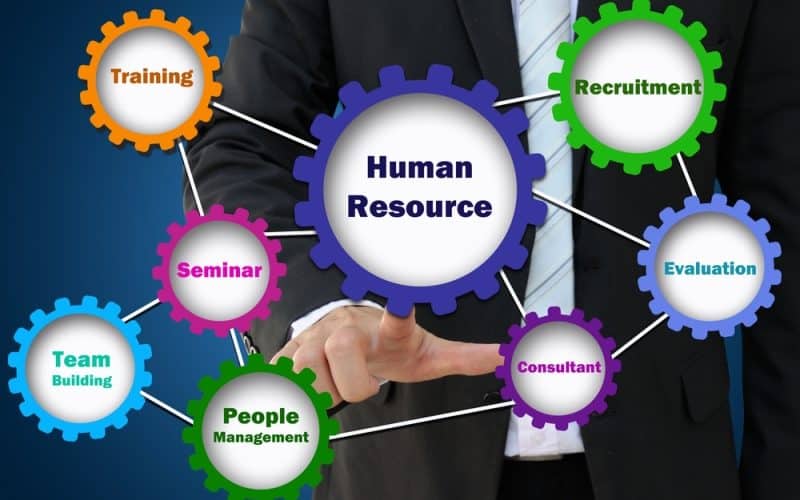The HR Department’s functions are varied and complex, as this team is in charge of managing a company’s human capital to accomplish defined business objectives. The personnel department is key in any business, from attracting and maintaining talent to protecting employees’ interests and well-being. According to Forbes magazine, a number of studies demonstrate the relevance of matching human resource strategy to achieve corporate objectives and improve business performance. According to studies, it is feasible to get a true competitive advantage through people, and organizations that do so obtain exceptional results. Everyone who is interested in Human Resources can anticipate a pleasant career. If you want to work in human resources, you need first to learn about the key functions of the HR department.
What are the Goals of a Human Resources Department?
To comprehend the functions of the HR department, it is necessary to understand what to anticipate from it and what goals it has. In general, we know that its main responsibility is to contribute to a company’s success by locating, retaining, and developing people resources. On the one hand, this is accomplished through the development of efficient programs while also ensuring that they adhere to established norms and regulations in this field.
More specifically, the HR department’s main goals are:
#1. Contribute to the company’s business goals.
A professional team of human resources is required to achieve organizational objectives. The CEO or board of directors must determine the needs of the organization, and the human resources team must identify the right individuals to meet those needs, both within and outside the organization.
#2. Attract and retain top talent
The human resources department must recruit and retain the best experts in the industry. This necessitates a well-planned strategy as well as the implementation of the appropriate programs to boost staff motivation and well-being.
#3. Enhance the well-being of staff
The human resources department must be committed to ensuring the well-being, motivation, and development of the company’s personnel. Measuring the working environment, launching development programs, and providing incentives are just some of the things they accomplish.
#4. Increase productivity
Internally, the personnel department must also monitor the productivity and performance of the entire workforce. They should be able to identify areas for improvement and initiate plans for implementation.
#5. Ensure that regulations are followed.
There are several employment policies and laws for which the human resources department is ultimately responsible. Vacations, sick days, maternity/paternity leave… Everything is regulated and must be strictly enforced.
What Does the HR Department Do?
People management, as defined by Fernando Arias G., author of Administración de Recursos Humanos (Human Resources Administration), is “the discipline that looks after the organization of employees that work in a company, in order to meet the objectives of both parties.” As this definition and the preceding points suggest, this department’s role is critical.
It is in charge of establishing a pleasant work climate and nurturing the well-being and productivity of the workforce, as well as looking after the needs and circumstances that emerge with the employees of an organization.
It is also where members of the organization go when they need assistance, counsel, or support. People in this department must therefore be in touch with the workplace and understand the specifics of the company, each employee, the present economic condition, and the labor market. Now let’s see a list of the key functions of the HR department.
List of the Key Functions of the HR Department
The human resources department is in charge of a variety of responsibilities and activities that benefit the company and its employees. As a result, the number of functions is nearly unlimited, and we may argue that HR functions are vast and quite diverse. All of these functions must be defined when establishing the HR department and developing a strategic plan.
The HR department’s key functions are as follows:
#1. Human resource planning
The human resources department is in charge of making strategies for the company’s future and employees. Many other HR functions, such as recruiting and hiring talent, performance management, and succession planning, are impacted by this role. HR experts must examine the company’s goals and objectives and devise workforce strategies to help them be met. They may, for example, expand hiring to fulfill production targets or attract personnel with a certain skill set to accomplish a project or endeavor. When planning, the HR department frequently engages with other departments to ensure that it knows their needs.
Several elements must be considered by the department while coordinating and implementing these plans. To establish consistent practices, they must ensure that their tactics connect with the company’s objective. HR experts must also keep an eye out for external issues that may have an impact on the organization, such as changes in laws or technology. Taking these actions can assist the organization in adapting to such changes as needed, allowing it to continue striving toward its vision and goals while remaining competitive in the market.
#2. Recruitment and selection of talent
The human resources department is critical to an organization’s ability to attract and retain talent. They may collaborate with management to set recruitment objectives and identify the types of applicants or roles that need to be filled. These professionals can also assist in the creation and uploading of job listings, the identification of qualified individuals, and the first screening process. They may browse professional networking sites or visit in-person events such as job fairs when looking for applicants.
Human resource specialists also help with the hiring and onboarding processes. They may issue a job offer to potential workers, give a start date, negotiate compensation, and initiate the benefits enrollment process. These specialists give a workplace orientation on the first day of employment to familiarize employees with the workplace and corporate regulations and procedures.
#3. Benefits and Compensation
The human resources department assists in the management and oversight of employee salary and benefits. They collaborate with management to set compensation and, where necessary, negotiate them with employees. When an employee is employed, the HR department enters them into their payroll system and is responsible for ensuring that they are paid on time according to the payment schedule. This department also monitors industry compensation norms to ensure that the company remains competitive. If the corporation is unable to provide a competitive wage, it may compensate with additional benefits.
Employees often receive a benefits package that includes health and dental insurance, life insurance, 401(k), and retirement plans, as well as paid time off. HR experts build these packages and enforce policies and procedures as part of their job. They may negotiate group discounts with insurance providers and organize retirement planning efforts. The HR department informs employees about their benefits by answering queries, reminding them of important deadlines, and even soliciting feedback on any other desirable advantages.
#4. Health and security
The human resources department is in charge of creating and executing workplace health and safety procedures. Employers are required to create a safe working environment under the Occupational Safety and Health Act of 1970 (OSHA). This department must be conversant with OSHA regulations and adhere to them by supervising safety training, monitoring injury logs, reporting injuries, and dealing with any compensation demands that occur as a result.
Implemented safety measures may be industry-mandated or designed to ensure general safety, such as harassment regulations and emergency planning.
#5. Compliance with labor laws
In addition to health and safety standards, the human resources department ensures that the organization complies with applicable labor laws. Compliance with such rules can aid in the prevention of complaints about employment practices or workplace conditions. Human resources specialists are educated on state and federal legislation such as the Fair Labor Standards Act, Title VII of the Civil Rights Act, the National Labor Relations Act, and the Family and Medical Leave Act.
To maintain compliance, these specialists manage documentation, create policies, and coordinate training. These rules address topics such as break requirements, working hours, harassment norms, and equal employment opportunities. They also update and manage company handbooks to ensure that employees are aware of their rights and protections. The HR department also handles any complaints about compliance and, if necessary, takes disciplinary action.
#6. Development and training
The human resources department oversees and supervises employee training and development as part of the HR planning process. New employees are often trained to learn corporate regulations and procedures, as well as the specific talents, equipment, or resources required to do their job. The HR department also collaborates with managers to develop and implement programs that teach existing employees specific skills or expertise. These opportunities are often designed to help employees improve their performance or achieve company goals. A corporation that deploys new technology, for example, may launch a program to teach staff how to use it.
Aside from internal training, the HR department may assist in coordinating employee participation in seminars, conventions, conferences, or opportunities for continuing education. Promoting professional development in the workplace might make employees feel more appreciated. This culture has the potential to reduce turnover while increasing production and efficiency.
#7. Labor and employee relations
The human resources department frequently supervises the relationships between employees and their managers. During a quarrel, an HR expert can act as a mediator. The agency is also in charge of dealing with employee workplace problems. It may also be in charge of managing union relationships in organizations having unionized staff. To maintain strong connections, the department ensures that corporate policies and processes satisfy union needs and engages with them on a regular basis. Maintaining contact with unions can also assist the company in identifying future difficulties and resolving them in order to avoid escalation, such as strikes or protests.
#8. Employee satisfaction
Human resource managers are also responsible for the general well-being of the organization’s personnel. To help employees avoid burnout, they should promote and implement health and wellness activities. They may, for example, encourage staff to use their vacation days or organize wellness initiatives. HR specialists may also provide specialized assistance to employees who are experiencing personal difficulties. They may offer specific tools or guidance to help lessen the problem, or they may discuss choices for the employee, including as time off and other perks.
#9. Performance Management
The human resources department is also responsible for monitoring the job performance of the company’s personnel. Employee and manager performance evaluations are common tasks in performance management. These activities aid in determining whether or not the workforce is reaching organizational goals and objectives. The insights collected might be used by the HR department to build or give training and development opportunities as needed. Exit interviews can also help HR personnel understand why employees choose to leave, which can help with performance management. If the department identifies a common issue, it can begin implementing changes to assist assure staff retention.
#10. Career Planning and Succession
The department may conduct career or succession planning activities as part of HR planning. When high-level roles are projected to become vacant, the HR department can collaborate with managers to identify top-performing individuals who could fill them. In addition to job performance, they may assess potential applicants based on their internal reputation and the necessary talents they can offer to the role. Having a succession plan in place can help the organization prevent disruption.
#11. Company culture and employee engagement
The HR department fosters an engaging workplace environment for its workers. It may organize activities such as retreats, tournaments, or office parties to encourage involvement and networking. These specialists may also create frequent newsletters to keep staff up to date on corporate news and activities. Employees who are engaged at work have higher morale and retention rates.
Another approach of engaging employees is to provide incentives or awards for their performance or involvement in workplace activities. For example, the corporation may establish a referral program to boost its hiring efforts and offer monetary incentives to individuals who refer candidates. Winners of contests can earn gift cards or other physical rewards. These kinds of rewards can help employees feel valued and motivated to come to work.
#12. Job assessment
The human resources department of a company may be in charge of assessing job roles. These professionals evaluate each job and determine the proper title, tasks, responsibilities, and abilities required to accomplish it. Because job descriptions change over time, the department is also responsible for revising them as needed. This duty can help with HR planning and recruitment. Positions are also evaluated by the agency to determine their worth. They employ diverse techniques, such as ranking positions or categorizing them. This evaluation assists the organization in determining how to fairly reward or compensate personnel in certain responsibilities.
#13. Administrative responsibilities
The human resources department is also in charge of the day-to-day administration of the workforce. They are in charge of preserving personnel records and files, as well as paperwork pertaining to onboarding and off-boarding, insurance policies, and employee contracts. Employees might seek clarification or support from these professionals regarding important workplace or administrative procedures and policies. Payroll and scheduling procedures, for example, may be handled by department professionals. The department also handles travel arrangements and business-related expenses as needed.
How to Improve HR Functions
You can use the stages below as a guide to building improved HR functions:
#1. Carry out training
HR professionals must attend training to keep their understanding of important employment laws, rules, and processes up to date. They may also take advantage of opportunities to develop skills critical to their roles, such as using certain software or delivering dispute resolution services. As these people continue to learn how to do their jobs, the team will be strengthened and HR processes will be improved.
#2. Adhere to the company’s mission.
Most organizations have a mission that they want to maintain or achieve. The HR department should keep the mission and corresponding values in mind when designing policies and procedures. Maintaining such alignment can assist assure consistency across all business areas and maintain focus on meeting the goals set by its leaders.
#3. Set your expectations
The HR department must underline the expectations for each role during the recruitment and hiring process. When new hires grasp such expectations, they are more prepared to take on the job’s obligations. It can also establish criteria for them to utilize in assessing their performance and making necessary improvements.
#4. Encourage openness.
To ensure that employees feel comfortable addressing their wants or problems, the HR department should implement an open communication policy. To acquire employee input, the department can also send out and handle anonymous surveys. When human resource professionals can observe how employees feel about their workplace, it can help them detect and resolve problems.
#5. Make use of human resource software.
Human resource information systems, for example, can assist the department in completing administrative activities more efficiently and effectively. Such software frequently includes automation technologies to assist save time and improve process consistency. It can also help to centralize employee data or other sensitive information, allowing for on-demand access.
Conclusion
Human resources is a multifaceted job that enables businesses to get the most out of their personnel. To operate across these core HR functions, you must have a diverse skill set as an HR professional. Education in HR cannot end with obtaining your core qualification. The workplace and society are always changing and evolving. You, too, must continue to grow in order to successfully lead your employees through change.
- MARKETING DEPARTMENT: Overview, structure, roles, expectations (+free tips)
- RESOURCE PLANNING: Definition, Example, Types, Enterprise & System
- Capital Resources Definition: Why It Is Key For All Businesses
- Everything You Need To Know About A Business Partner
- EMPLOYEE DEVELOPMENT PLAN: Ultimate Guide on How to Create One With Examples






